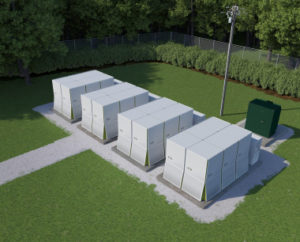
One part of the problem: what happens when a pipeline explodes. Photo: Wikimedia Commons
By George Harvey
Costs for battery storage are falling much more sharply than most analysts anticipated. They have fallen so much in the last two years that they are already having effects on the natural gas market. An example of this can be seen at Aliso Canyon, where a 120-megawatt hour (MWh) battery was installed after last year’s gas leak, to reduce dependence on natural gas. The effects are now projected only to become more pronounced and may soon be disruptive to the use of natural gas at the utility scale.
Two years ago, RenewEconomy published “Energy storage to reach cost ‘holy grail’, mass adoption in 5 years.” (http://bit.ly/RE-energy-storage-projection) The article was based on projections from a paper published privately by Deutsche Bank and a paper from the Rocky Mountain Institute (RMI). The article claimed that the price of batteries would fall to a level that would be disruptive within five years.
We should note that electricity and batteries are both priced in terms of cost per kilowatt hour (kWh), but the values are not comparable. One is the cost of electricity, and the other is the cost of the equipment used to store the electricity. It is rather like comparing the cost of a certain quantity of oil with the cost of an oil truck that would carry that quantity.
RMI’s 2015 projections for the cost of battery storage showed declines from about $700/kWh in 2013 to a projected cost of about $470/kWh in 2017. RMI expected the cost to decline to about $400/kWh in 2020.
The Deutsche Bank’s projections showed steeper declines in the cost of electricity delivered by the battery. This may have been partly because the decline in battery prices would be accompanied by other improvements, such as improved battery life. The bank showed that the price of electricity from batteries would fall from about 14¢/kWh in 2015 to a projected 2¢/kWh in 2020.
Now, two years have passed, and we can see that the projections were rather far off the mark, as the costs of battery storage have fallen much faster than anticipated. Many people know that the cost of the 10 kWh Tesla Powerwall, which has wide appeal to households, has dropped greatly. At the utility scale, however, the Powerwall is not the least expensive battery available.
The example I will use is the Eos Aurora battery, which is available is sizes of 1000 kWh and larger. It has been installed widely and is the least expensive battery I could find. (http://bit.ly/eos-aurora-pricing)

One part of the solution: a battery system. Photo courtesy of Eos.
While RMI expected a drop to $470/kWh in 2017, the price of the Eos Aurora battery was $200/kWh for systems below 40 MWh at the end of 2016, and $160/kWh for those that are larger. A one-MWh battery is expected to supply 13,000 MWh, virtually without maintenance. This comes to less than 1.6¢/kWh, not including marginal costs, over the unit’s lifetime. It is not the cost of electricity, but the cost of holding the electricity. It is an added cost for the portion of the electricity that comes from the battery.
The Eos battery is not alone. Prices are being reduced by a number of companies. Green Energy Times had an article, The ViZn Flow Battery, in the December 2016 issue. You can find that online at http://bit.ly/GET-vizn-flow-batteries.
To see the implications of this, we could look to “Lazard’s Levelized Cost of Energy Analysis – Version 10.0” (http://bit.ly/Lazard-LCOE-10), which was released in December of 2016 and based on figures from that year. That source gives the cost of utility scale solar power at a range from 4.6¢/kWh to 6.1¢/kWh, while the cost of wind power ranged from 3.2¢/kWh to 6.2¢/kWh.
However, if we take the cost of “24-7” power from solar power above and increase it for the cost of battery storage at 1.6¢/kWh for simplicity’s sake, the combination comes into the range of 6.2¢/kWh to 7.7¢/kWh. These figures are actually high, because they assume a need to store for all of the solar power and are, in fact, an unrealistic maximum. Also, because the wind blows most when the sun is not shining, the battery power to back up solar and wind power is lower than the back-up solar alone. With hydro power and biogas also available, the lean times are further reduced.
The range in cost of 6.2¢/kWh to 7.7¢/kWh is far below the cost of electricity from natural gas peaking plants, which have costs ranging from 13.8¢/kWh to 22.2¢/kWh and are also inferior to batteries in their response times. It is well below the cost of nuclear power, which ranges from 9.7¢/kWh to 13.6¢/kWh. It is very competitive with coal, which has costs of 6¢/kWh to 14.3¢/kWh, and it is getting competitive with combined-cycle natural gas plants, which have costs ranging from 4.8¢/kWh to 7.8¢/kWh.
We cannot know how costs will change in advance. Solar costs have been declining at 30% per year. Wind costs have declined about 10%. Batteries have recently declined at over 25%, though the last years’ declines seem much faster. Assuming average cost declines of 20% per year for solar, wind, and batteries, the combined cost of power could get to 3.2¢/kWh to 4¢/kWh by 2020. And the point when there is no reason to build natural gas plants or pipelines comes well before that.








Leave a Reply